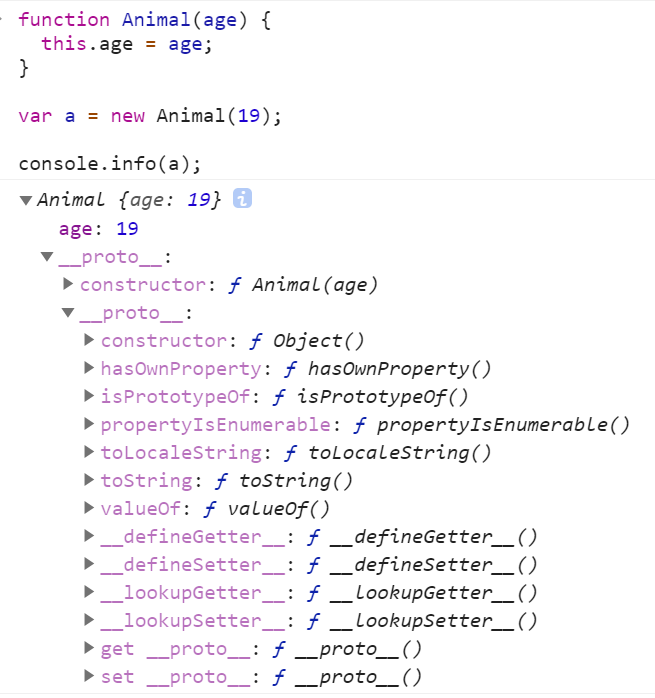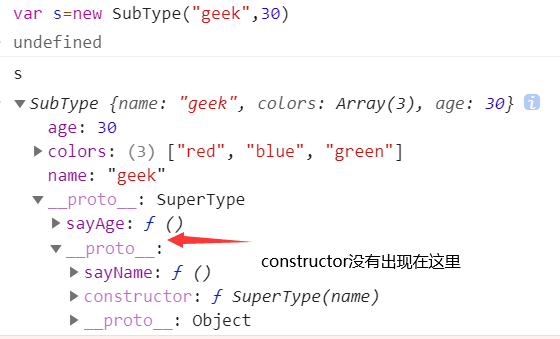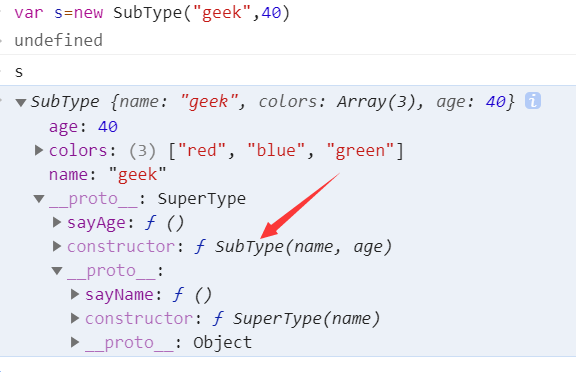ES5 继承
作者:assassin cike
来源:SegmentFault 思否社区
首先要明白两点:
一、非方法属性每个子类实例需要独立
二、方法属性每个子类实例需要共享
为什么?
如果非方法属性为引用类型,且非方法属性共享,在一个实例中改变,其他实例中就会做出改变,这样每个实例就会相互影响,而方法属性一般是不需要进行改变的,只是对方法调用。
方法跟属性分别可以定义在构造函数内部跟prototype上。
继承的目的是子类继承父类的方法跟属性。
代码主要来自于红宝书4
基于原型链的继承
每个函数都有个prototype属性,每个对象都有__proto__属性(在chrome中表现如此,prototype也是如此) 如图,属性的查找会从当前层级依次向原型链上查找,直到查找到原型链的顶端null,具体可参考:
js proto(https://www.jianshu.com/p/cd26f07df9ba)

既然属性的查找是按照原型链向上查找的,且继承就是继承父类的属性跟方法,那么就可以利用这个特性,进行继承。
function SuperType() {
this.property = true;
}
SuperType.prototype.getSuperValue = function () {
return this.property;
};
function SubType() {
this.subproperty = false;
}
// 继承SuperType
SubType.prototype = new SuperType();
SubType.prototype.getSubValue = function () {
return this.subproperty;
};
let instance = new SubType();
console.log(instance.getSuperValue()); // true 可以正确调用父类的方法,拿到父类的属性
原型虽然实现了继承,但是还是有缺点的
劣势:
1. 子类或者父类的属性为引用类型时,改变一个实例的引用类型属性,其他实例的该引用类型属性也会发生改变,这样其实例就会相互污染了。
function SuperType() {
this.colors = ["red", "blue", "green"];
}
function SubType() {} // 继承SuperType
SubType.prototype = new SuperType();
let instance1 = new SubType();
instance1.colors.push("black");
console.log(instance1.colors);
// "red,blue,green,black";
let instance2 = new SubType();
console.log(instance2.colors);
// "red,blue,green,black";
为什么非方法属性不写在prototype上?
因为prototype上的属性的共享的,在一个实例上改了该属性,其他实例的该属性也会被改掉。
为什么方法不写在构造函数内部?
方法写在子类内部:每次实例化构造函数,方法都是新的;方法只是用来调用,不需要修改,所以实例共享就行了。
方法写在父类内部:不同的子类继承父类都需要实例化父类;方法只是用来调用,不需要做修改,所以实例共享就行了,包括子类实例。如果子类需要修改父类方法,直接在子类中定义相同方法名,进行覆盖就行了。
2. 子类在实例化时不能给父类的构造函数传参,因为父类的实例化是在前面,而不是构造函数调用的时候。
盗用构造函数
为了解决父类中属性为引用类型导致子类实例化后,引用属性共享的问题,跟父类构造函数无法传参的问题。引入了“盗用构造函数“方式实现继承。思路是在子类构造函数中调用父类构造函数。
不同实例的引用属性不会相互影响
function SuperType() {
this.colors = ["red", "blue", "green"];
}
function SubType() {
// 继承SuperType
SuperType.call(this);
}
let instance1 = new SubType();
instance1.colors.push("black");
console.log(instance1.colors);
// "red,blue,green,black";
let instance2 = new SubType();
console.log(instance2.colors);
// "red,blue,green";
可以为父类构造函数传参
function SuperType(name) {
this.name = name;
}
function SubType(name) {
// 继承SuperType并传参
SuperType.call(this, name);
// 实例属性
this.age = 29;
}
let instance = new SubType("geek");
console.log(instance.name); // "geek";
console.log(instance.age); // 29
定义在父类prototype上的方法,子类无法继承
function SuperType(name) {
this.name = name;
}
SuperType.prototype.say = function () {
console.info("hello");
};
function SubType(name) {
// 继承SuperType并传参
SuperType.call(this, name);
// 实例属性
this.age = 29;
}
let instance = new SubType("geek");
console.log(instance.name); // "geek";
console.log(instance.age); // 29
instance.say() // 获取不到该函数
定义在父类构造函数中方法无法共享
组合继承
function SuperType(name) {
this.name = name;
this.colors = ["red", "blue", "green"];
}
SuperType.prototype.sayName = function () {
console.log(this.name);
};
function SubType(name, age) {
// 继承属性,绑定上下文为SubType的实例
SuperType.call(this, name);
this.age = age;
}
// 继承方法
SubType.prototype = new SuperType();
SubType.prototype.sayAge = function () {
console.log(this.age);
};
let instance1 = new SubType("Nicholas", 29);
instance1.colors.push("black");
console.log(instance1.colors);
// "red,blue,green,black"
instance1.sayName(); // "Nicholas";
instance1.sayAge(); // 29
let instance2 = new SubType("Greg", 27);
console.log(instance2.colors);
// "red,blue,green";
instance2.sayName(); // "Greg";
instance2.sayAge(); // 27
可以传递参数到父类构造函数
两个实例中的引用类型不会相互影响
实例可以调用父类的方法,且实现方法的共享
组合继承也保留了 instanceof 操作符和isPrototypeOf() 方法识别合成对象的能力。
SuperType会被调用两次,SubType实例跟原型链上都有name跟colors属性。
原型式继承
function object(o) {
function F() {}
F.prototype = o;
return new F();
}
let person = {
name: "Nicholas",
friends: ["Shelby", "Court", "Van"],
};
let anotherPerson = object(person);
anotherPerson.name = "Greg";
anotherPerson.friends.push("Rob");
let yetAnotherPerson = object(person);
yetAnotherPerson.name = "Linda";
yetAnotherPerson.friends.push("Barbie");
console.log(person.friends);
// "Shelby,Court,Van,Rob,Barbie";
let person = {
name: "Nicholas",
friends: ["Shelby", "Court", "Van"],
};
let anotherPerson = Object.create(person);
anotherPerson.name = "Greg";
anotherPerson.friends.push("Rob");
let yetAnotherPerson = Object.create(person);
yetAnotherPerson.name = "Linda";
yetAnotherPerson.friends.push("Barbie");
console.log(person.friends);
// "Shelby,Court,Van,Rob,Barbi
父对象的引用类型会在实例中共享,这样就会相互污染。
寄生式继承
工厂函数的定义:
function createAnother(original) {
let clone = object(original);
// 通过调用函数创建一个新对象;
clone.sayHi = function () {
// 以某种方式增强这个对象;
console.log("hi");
};
return clone; // 返回这个对象
}
let person = {
name: "Nicholas",
friends: ["Shelby", "Court", "Van"],
};
let anotherPerson = createAnother(person);
anotherPerson.sayHi(); // "hi"
父对象的引用类型会在实例中共享,这样就会相互污染。
方法无法实现共享
寄生式组合继承
先看下组合继承:
function SuperType(name) {
this.name = name;
this.colors = ["red", "blue", "green"];
}
SuperType.prototype.sayName = function () {
console.log(this.name);
};
function SubType(name, age) {
SuperType.call(this, name); // 第二次调用,将父类的属性绑定到子类的实例中
SuperType();
this.age = age;
}
SubType.prototype = new SuperType();
// 第一次调用SuperType();
SubType.prototype.constructor = SubType;
SubType.prototype.sayAge = function () {
console.log(this.age);
};
父类的属性是需要的,父类的原型上的方法是需要的,重复的父类属性不需要,由上图可见重复的父类属性是由于实例化父类给子类原型造成的,我们不去实例化父类,而是将父类的原型传递给子类的原型就行了,结合原型式继承特点可以做到
function SuperType(name) {
this.name = name;
this.colors = ["red", "blue", "green"];
}
SuperType.prototype.sayName = function () {
console.log(this.name);
};
function SubType(name, age) {
SuperType.call(this, name); // 将父类的属性绑定到SubType实例中
this.age = age;
}
SubType.prototype = Object.create(SuperType.prototype);
// 将子类的prototype关联到父类的prototype上
SubType.prototype.sayAge = function () {
console.log(this.age);
};

SubType.prototype = Object.create(SuperType.prototype, {
constructor: {
value: SubType, // 修正 constructor 指向
writable: true,
configurable: true,
},
});

SuperType的constructor出现了,其实constructor并没什么用,只是个约定罢了,参考贺老的解释JavaScript 中对象的 constructor 属性的作用是什么?(https://www.zhihu.com/question/19951896/answer/13457869)
算是引用类型继承的最佳模式


